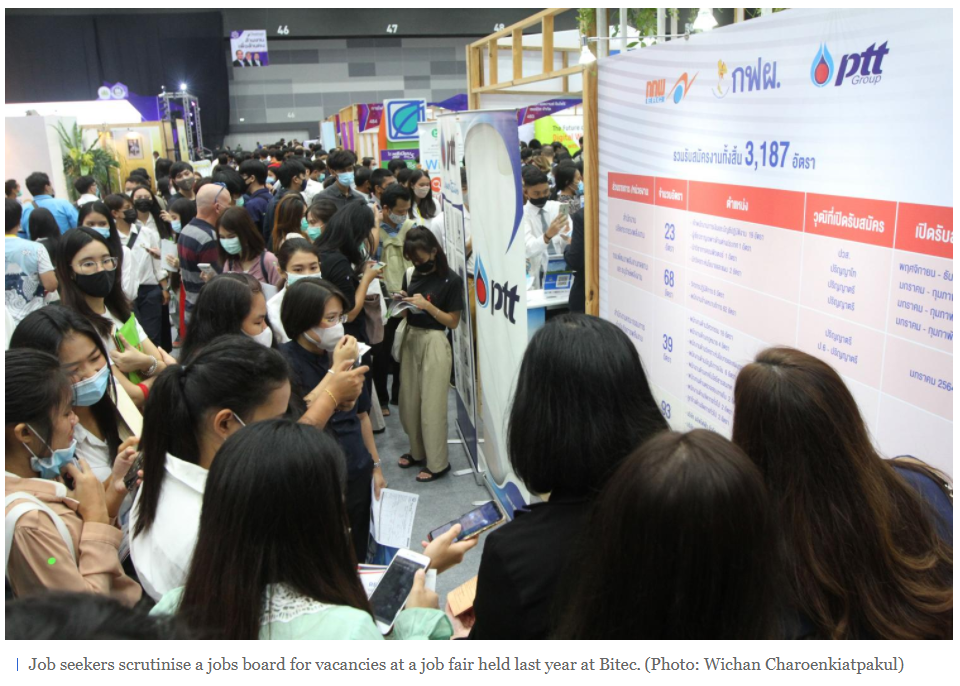Thai youth unemployment at new high
Joblessness among young men and women in Thailand has reached a level unseen in recent years due to the impact of the Covid-19 pandemic, according to the International Labour Organization (ILO).
Youth employment fell by 7% in the first quarter of 2021 from the fourth quarter of 2019, the United Nations agency said in its Thailand Labour Market Update released this week. The youth unemployment rate increased by 3 percentage points for both men and women, reaching a high of 6% and 8%, respectively.
According to the report, pandemic-related restrictions particularly affected employment in smaller establishments with fewer than 50 workers. Youth employment in these establishments suffered the most, falling by 18% for young men and by 24% for young women.
“If small establishments were one of the channels for youth to get employment, the channel has severely narrowed,” the report noted.
“The impact of Covid-19 on the Thai economy has seen young people and small establishments especially hard hit,” said Graeme Buckley, the ILO country director for Thailand, Cambodia and Laos.
“Targeted responses focusing on key sectors and segments of the workforce are vital for recovery, as are continuing efforts to ensure everyone receives a vaccination, including migrant workers.”
Between the fourth quarter of 2019 and the first quarter of 2021, total working hours fell by 7%, or a decline in full-time equivalent employment by 2 million across the whole workforce, the ILO said. A fairly strong recovery in working hours and employment in the last half of 2020 was reversed in the first quarter of 2021 due to the re-emerging waves of the pandemic.
A looming concern for the workforce overall is the impact the pandemic has had on Thailand throughout all of 2021. The cumulative and drawn-out negative impact of pandemic-related restrictions on incomes, employment, hours of work and productivity is a serious concern.
In the third quarter, the stringency of Covid-19 restrictions was equivalent to that of the second quarter of 2020. A similar magnitude of socioeconomic shock as the one seen in the second quarter of 2020 could therefore be expected, it added.
The Covid crisis comes on top of longer-term economic and employment challenges in Thailand and may have reversed any recent progress, according to the ILO. For example, wage inequality increased year-on-year in the second quarter of 2020. Wages increased at the top of the distribution, while the low-pay ratio trended upward on a quarterly basis in 2020.
In the second quarter of 2021, the hardest-hit sectors were accommodation and food services (61% of the value added seen in the fourth quarter of 2019), transport and storage (74%), and wholesale and retail trade (95%). The three sectors accounted for 30% of non-agricultural GDP in 2019.
Other sectors have either recovered, such as agriculture and manufacturing, or continued to expand through the pandemic, such as construction, information and communication technology and real estate. Thus, there are temporary cross-sectoral imbalances.
“If the socioeconomic crisis is further prolonged, any existing cross-sectoral mismatch in the labour market can worsen and become structurally embedded,” said the ILO report.
While employment began to grow this year in many sectors, it was accompanied by a fall in labour productivity. Sectors that experienced positive growth in both employment and labour productivity include finance and insurance, education and construction. The agricultural sector experienced a notable employment and productivity decline between the fourth quarter of 2019 and the first quarter of 2021.
The incidence of part-time employment increased in almost all sectors over the same period, including professional, scientific and technical activities (by 23 percentage points), manufacturing (up 20 points), and information and communication (up 19 points). Thus, while employment may have been maintained, the volume of work in terms of hours has weakened, said the ILO.
In spite of difficult conditions, the overall response of workers during the first year of the pandemic has been to stay in the labour market. This may have been supported by the employment protection measures that were put in place in 2020.
With the gradual easing of health-related restrictions, rising vaccination rates and the announced easing of cross-border mobility in November 2021, a slow and uneven recovery could be expected in the last quarter of 2021 and into 2022, the report concluded.
Source: https://www.bangkokpost.com/business/2221279/thai-youth-unemployment-at-new-high


 Thailand
Thailand




